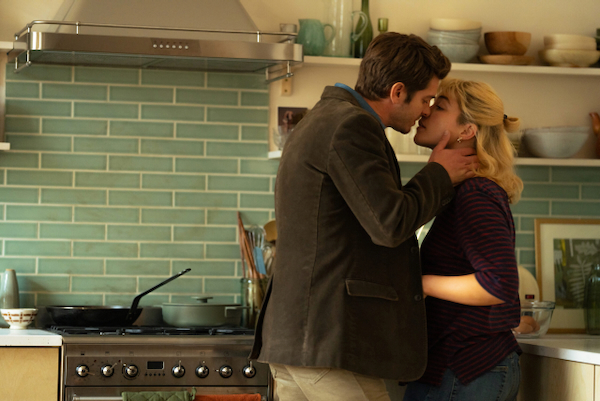Movie review by Greg Carlson
The unsurprising reality that director John Crowley offers absolutely nothing new should not – and will not – deter fans of the weepie from purchasing tickets to “We Live in Time.” The opportunity to see the impossibly appealing domesticity and sparking chemistry of Florence Pugh and Andrew Garfield as a fantasy couple faced with a double dose of ovarian cancer implores us to get out our very best embroidered hankies and buckle up for a ride on the Sirk Super Slingshot. Crowley, the Irish theatre veteran with plenty of solid television and film credits, is arguably best known in the United States for “Brooklyn.” “We Live in Time” should provide the workaholic with another success.
Crowley handles Nick Payne’s screenplay with machine-like efficiency, although the deliberately jumbled organization of the timeline fails to add value to the telling. This achronological presentation of the too-short partnership of Pugh’s aspiring chef Almut Brühl and Garfield’s Weetabix employee Tobias Durand may not do any significant damage to the movie’s legibility, but one is hard-pressed to see how the time-jumps enhance the story. Like recent release “The Outrun,” starring Crowley’s “Brooklyn” lead Saoirse Ronan, it is possible to read the sliced-up story beats as the point-of-view of a character making sense of or reflecting on life events.
“We Live in Time” should serve as a textbook for the kind of well-used tropes that Roger Ebert both coined and collected from readers before publishing the indispensable “Ebert’s Little Movie Glossary” in 1994. The subtitle of the book reads, “A compendium of movie clichés, stereotypes, obligatory scenes, hackneyed formulas, shopworn conventions, and outdated archetypes.” And while there is no shame in acknowledging that many of us keep going to the movies because they feature these familiar phenomena, “We Live in Time” deserves a gold trophy for the sheer commitment with which our filmmakers honor some classic entries.
Behold the shamelessness of the film’s meet-cute, in which Almut strikes Tobias with her car, sending her future lover to the hospital. It gets better: Tobias was inexplicably roaming the motorway in search of a working pen when his hotel room stylus couldn’t produce enough ink to sign his divorce papers! Marvel at the comic hijinks of the fuel station bathroom birthing scene, which joins a lengthy list of movies in which some of our finest thespians wring comic mileage from babies arriving in unexpected/inconvenient locations. Later, someone will forget to pick up a child from school, setting up a key showdown complete with obligatory tears and recriminations.
When his partner faces a round of chemotherapy, Tobias shaves Almut’s head, revealing an even more beautiful and radiant Pugh (a quintessential example of one of the very best Ebert-isms, “Ali MacGraw’s Disease”). Through it all, Pugh and Garfield make us believe while they make-believe. When we discover that Almut mysteriously elected not to share with Tobias that she used to be a world-class competitive figure skater, something tells us to file that information for what will turn out to be a tear-jerking future scene at the ice rink. For reasons such as these, and for the genius publicity tie-ins (like the “Sesame Street” chat with Elmo during which Garfield discusses grieving his late mother and the actor showing up with a cardboard cutout of Pugh at the film’s London premiere), we will live in time with “We Live in Time.”
